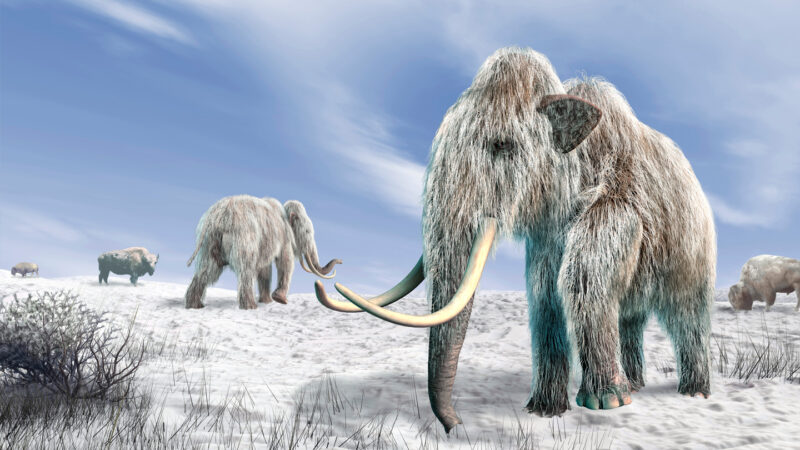Some ancient DNA may be leading paleontologists astray in attempts to date when woolly mammoths and woolly rhinos went extinct.
In 2021, an analysis of plant and animal DNA from sediment samples from the Arctic, spanning about the last 50,000 years, suggested that mammoths survived in north-central Siberia as late as about 3,900 years ago (SN: 1/11/22). That’s much later than when the youngest mammoth fossil found in continental Eurasia suggests the animals died out; it dates to about 10,700 years ago. Only on Wrangel Island off the coast of Siberia and the Pribilof Islands in the Bering Sea were mammoths known to have survived later.
The finding was one of several in recent years using ancient DNA found in sediment and other environmental material to suggest new insights into animal extinctions. Genetic evidence from woolly rhinos in Eurasia and horses in Alaska have also indicated that these animals remained thousands of years longer in some areas than was thought.
But thousands of years is also how long the animals’ large bones can linger on the ground in the frigid north, slowly weathering and shedding tiny bits of DNA, two researchers write November 30 in Nature.
That means that the youngest ancient DNA in sediment samples may have come from such bones, not living mammoths, woolly rhinos and other megafauna. Studies that rely on this genetic evidence could skew estimates of when these animals went extinct by thousands of years toward the present, say paleontologists Joshua Miller of the University of Cincinnati and Carl Simpson of the University of Colorado Boulder.
When, and why, mammoths and some other Ice Age creatures died out is a lingering mystery. Dating when these animals went extinct could help reveal what drove them to their demise — humans, a warming climate, some combination of the two or something else entirely (SN: 11/13/18; SN: 8/13/20).
But getting a good sense of when a species disappeared from its range, or from the planet, is not straightforward. For long-gone animals, fossils can help, but it would be a huge coincidence if the youngest fossil ever found of an extinct species was also the last individual to live.
Where fossils give out, DNA has started to take over. For the last two decades, environmental DNA, or eDNA, has become a go-to technique to find out what organisms are living, or used to live, in a certain place (SN: 1/18/22).
Paleontologists generally focus on a variant of eDNA that gloms onto minerals and other material and gets buried over time. That “sedimentary ancient DNA,” or sedaDNA, is what evolutionary geneticist Yucheng Wang of the University of Cambridge and his colleagues analyzed in the 2021 study on mammoths.
“The DNA can come from a living animal, but it can also come from poop, from bones,” Miller says. “In our case, we’re focusing on bones.”
In warmer climates, a bone lasts long enough to spread DNA for at most a few decades, which usually is not important for getting a general date of extinction, he says. “But up in these cold settings, you would expect a much, much larger, even millennial-scale gap.”
From astronomy to zoology
Subscribe to Science News to satisfy your omnivorous appetite for universal knowledge.
Miller and Simpson base their estimates of how long the bones of dead mammoths can shed DNA into the environment on radiocarbon dating of the bones of large animals found on the Earth’s surface in cold places today. Caribou antlers as old as 2,000 years have been found on the islands of Svalbard in Norway and Ellesmere Island in Canada, and 5,000-year-old remains of elephant seals near the coastline of Antarctica.
Wang and his colleagues disagree that the mammoth eDNA in their sample could be partly from cold, old bones weathering down. In a reply in the same issue of Nature, they point out, for instance, that the very youngest mammoth eDNA they found shows low genetic diversity, precisely what you’d expect if the DNA actually came from a declining population at the end of the mammoth’s time on Earth, instead of from a thriving population earlier on.
“I think Miller and Simpson bring up a valid point for further testing and analysis,” says evolutionary geneticist Hendrik Poinar, a pioneer of eDNA research who wasn’t involved in the 2021 mammoth study. “But I don’t think that their analysis is nearly sufficient to combat the multiple avenues of evidence which suggest late persisting megafauna,” says Poinar, of McMaster University in Hamilton, Canada. He points out, for example, that in Wang’s study the DNA evidence tracks the plants of the time period. This suggests woolly mammoths in north-central Siberia could persist thanks to the steppe-tundra, which was their natural habitat, holding on there.
For Miller, the time span between the youngest known mammoth skeletal remains from north-central Siberia and the youngest mammoth eDNA reported by Wang and his colleagues is just too suspicious.
“That paper gives us scientific permission to really expect bones to be out there that are much younger than we have seen. There should be dozens, or hundreds of [such relatively recent] dead mammoths somewhere,” he says. “People have been looking for them…. And you just don’t find anything younger.”


